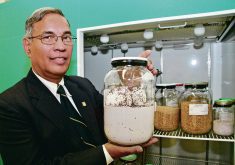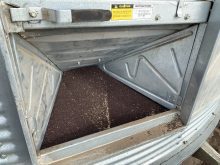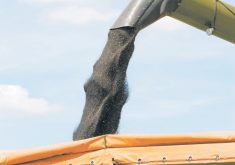After a long, hard harvest farmers deserve some time off over Christmas, but to ensure a “happy new year,” they should check their canola bins for heating.
“Canola and other grains will respire for about six weeks after harvest so even if a guy thinks he has put it in dry and cool it can respire and the moisture can go up and you can get hot spots in the bin,” said Manitoba Agriculture, Food and Rural Initiatives’ oilseed specialist Anastasia Kubinec. “Then you can have some crusting on the top.”
Read Also

Manitoba sclerotinia picture mixed for 2025
Variations in weather and crop development in this year’s Manitoba canola fields make blanket sclerotinia outlooks hard to pin down
A lot of canola went into storage tough. Some was frost damaged or had a high percentage of green seed. All can contribute to seed heating and spoiling.
Some crushers say they’ve already received some heated canola, Kubinec said.
“They were quite concerned,” she said.
Bins unequipped with heat sensors should be probed. Ideally grain should be taken from the centre of the bin where moisture and hot spots tend to develop and the seed temperature and moisture content taken.
If the seed is too warm or damp, aeration fans should be turned on and seed pulled from the bottom of the bin and poured on top to break any crusting that may have occurred.
Although grain companies will buy canola at 10 per cent moisture, it needs to be eight or nine per cent for safe long-term storage.
Aeration fans should be started as soon as the canola covers the perforated bin floor and operated continuously in the fall until either the crop temperature is reduced
to 0C or the crop is dry, according to information from Alberta Agriculture.
Temperature differences in stored canola results in moisture moving from warmer to colder areas of the bin, according to information from the Canola Council of Canada. During late fall, cold air sinks in the grain at the outside of the bulk and warm, moister air, in the centre of the bulk, rises and condensation may occur when it reaches the cold seeds near the surface. This free moisture near the surface can lead to rapid spoilage.
“If a guy came in with 20 per cent heated canola he would lose $100 a tonne off of No. 1 so it starts adding up pretty quick,” Kubinec said.
Canola that’s 0.2 to 0.5 per cent heated drops to a No. 2 grade. Canola that’s 0.5 to two per cent heated is No. 3. Anything over two per cent heated is sample grade. [email protected]



















